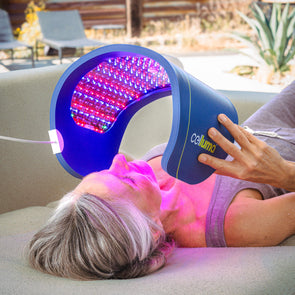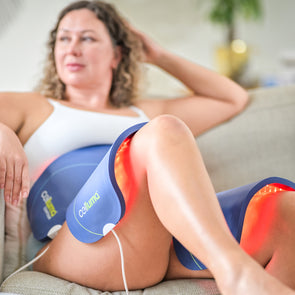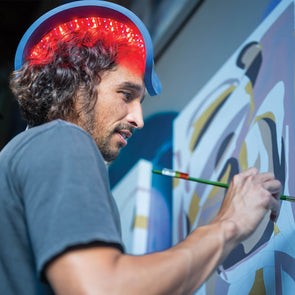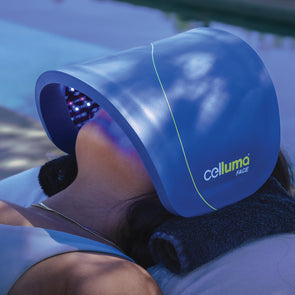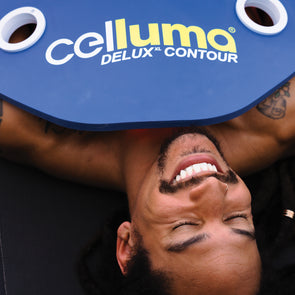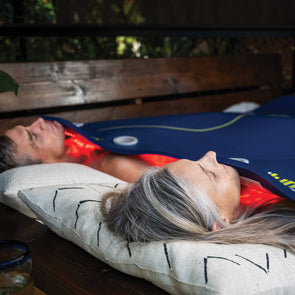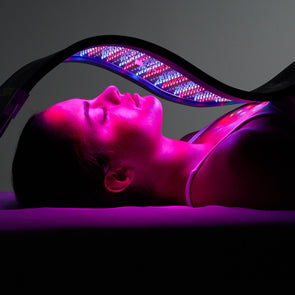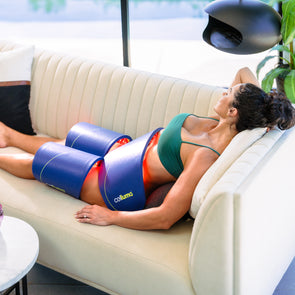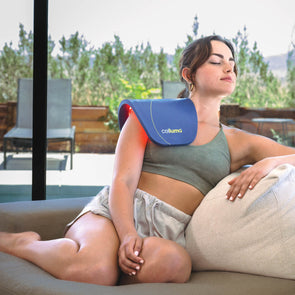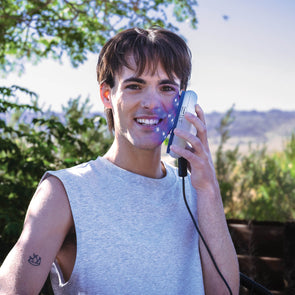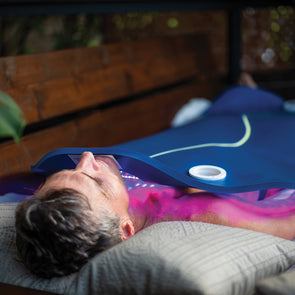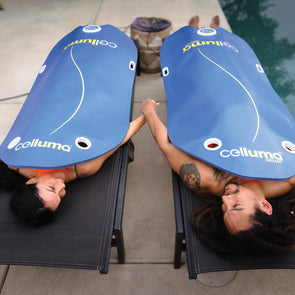Red Light and Blue Light Therapy for Acne Treatment

According to the American Academy of Dermatology, acne is the most common skin condition in the U.S. impacting approximately 50 million Americans annually. And approximately 85% of those suffering from acne are between the ages of 12 and 24-years-old.
However, acne can occur at any stage in life, even into a person’s 30s and 40s. The Academy has also found that acne in adults is increasing with 15% of sufferers being women. The inflammation and redness associated with acne can cause many young adults to suffer from self-esteem issues. Desperate for healing, many young teens and adults are looking for skin care solutions that will eliminate the blemishes and lesions that come with acne.
People may seek relief from their dermatologist or other medical professional. The Academy estimates that more than 5.1 million people “sought medical treatment for acne in 2013, primarily children and young adults.

Acne Treatment Costs are Staggering
And the costs of treating acne are staggering. In 2013 alone, the Academy estimates that the “costs associated with the treatment and lost productivity among those who sought medical care for acne exceeded $1.2 billion” and the “lost productivity among patients and caregivers due to acne was nearly $400 million.”
Acne Causes
The Academy states that it is “impossible to predict who will develop more severe acne but you have a higher risk if one or both of your parents (or other close blood relative) had severe acne that left them with acne scars.”
There are other contributions factors to acne including smoking, stress (which can worsen existing acne), getting too little sleep, eating certain inflammatory foods, and using inappropriate makeup or skin care products.
Acne Symptoms
According to WebMD, acne symptoms include:
- Recurring red spots or swelling on the skin (also known as pimples), typically appearing on the face, chest, shoulders, neck, or upper back.
- Dark spots with open pores in the center (also known as blackheads).
- Small white bumps under the skin (also known as whiteheads).
- Red lumps (known as papules) visibly filled with pus.
- Lumps under the skin that are inflamed, filled with fluid and tender to the touch.
Acne Treatment Options
Consulting a dermatologist is often the first line of defense for those suffering from persistent acne cases. The most successful treatments inhibit sebum production, limit the growth of bacteria, and unclog pores to clear up the skin. There are also prescription medications to treat the symptoms of acne but these options often come with concerning side effects.

Blue Light
If you suffer from severe or even moderate acne and have done your own homework or asked a dermatologist about effective acne treatments, you may have come across research or products related to light emitting diode (LED) blue light therapy. Blue light therapy is a proven acne treatment for people who have tried other acne treatments, but still aren’t achieved the results they want.
Light emitting diode or LED light therapy used to only be available at a dermatologist or esthetician’s office, but with the advent of affordable, effective, at-home light therapy device design, blue light for acne is becoming a household treatment that’s non-toxic, non-invasive, and really, really effective.
How Light Therapy Works
Light emitting diode or LED light therapy works by killing acne-causing bacteria at the source, deep beneath the skin’s surface. As people across the nation are searching for more natural, chemical-free alternatives to traditional medical solutions, light therapy, particularly blue light treatments, fits the bill perfectly.
Introducing Red Light
Blue light, especially in combination with red light therapy, emits specific, clinically-proven wavelengths of light to trigger an all-natural effect in human tissue, killing acne-causing bacteria, decreasing inflammation, reducing redness, and improving skin tone, texture, and clarity from the inside out. However, not all light therapy is created equal.
Blue light and red light therapy is widely used as an effective option for the treatment of mild to moderate inflammatory acne vulgaris. One study concluded that “…blue light and red light may act synergistically in improving acne by combining antibacterial and anti-inflammatory action, rendering phototherapy with blue and/or red light an effective and safe treatment for acne vulgaris”.₁
Healing the Skin: Red Light & Blue Light
The study mentioned above, “evaluated the use of blue light and a mixed blue and red light in the treatment of acne vulgaris. One hundred and seven patients with mild to moderate acne vulgaris were randomized into four treatment groups: blue light, mixed blue and red light, cool white light and 5% benzoyl peroxide cream. Subjects in the phototherapy groups used portable light sources and irradiation was carried out daily for 15 min. Comparative assessment between the three light sources was made in an observer-blinded fashion, but this could not be achieved for the use of benzoyl peroxide.”
“Assessments were performed every 4 weeks. After 12 weeks of active treatment a mean improvement of 76% (95% confidence interval 66±87) in inflammatory lesions was achieved by the combined blue±red light phototherapy; this was significantly superior to that achieved by blue light (at weeks 4 and 8 but not week 12), benzoyl peroxide (at weeks 8 and 12) or white light (at each assessment). The final mean improvement in comedones by using blue±red light was 58% (95% confidence interval 45±71), again better than that achieved by the other active treatments used, although the differences did not reach significant levels. We have found that phototherapy with mixed blue±red light, probably by combining antibacterial and anti-inflammatory action, is an effective means of treating acne vulgaris of mild to moderate severity, with no significant short-term adverse effects.”

More Acne Treatment Studies
In a 2013 study of Korean patients with acne vulgaris, researchers evaluated the “efficacy, safety, and histological changes of combined blue light and red light LED phototherapy for acne vulgaris.” Researchers ultimately concluded, “This LED phototherapy was safe and effective for treating not only inflammatory but also non-inflammatory acne lesions, with good compliance. The experimental results correlated well with clinical results, partly elucidating the related molecular mechanisms.”
Of all the acne treatment options, more and more research is finding that the combination of blue light and red light is effective, safe, and with little to no side effects. Is your dermatologist recommending light therapy? Did you know you can utilize blue light and red light therapy at home to kill acne bacteria and promote healing skin?
A Winning Combination
And yet another study examined the impact of both blue light and red light phototherapy. Researchers found that, “acne vulgaris represents both a challenge to the treating dermatologist and a major concern for the patient.
Conventional treatments have proved inconsistent with often unacceptable side effects and high rates of recurrence. Non-thermal, non-laser, LED phototherapy for acne with a combination of blue and red light has recently attracted attention.”²
Results and Conclusions
Researchers found that of the 22 patients who completed the trial, “a mean reduction in lesion count was observed at all follow-up points. At the 4-week follow-up, the mean lesion count reduction was significant at 46% (p50.001). At the 12-week follow-up, the mean lesion count reduction was also significant at 81% (p50.001). Patient and dermatologist assessments were similar. Severe acne showed a marginally better response than mild acne. Side effects were minimal and transitory. Comedones did not respond as well as inflammatory lesions. Researchers concluded that “combination blue and red LED therapy appears to have excellent potential in the treatment of mild to severe acne. Treatment appears to be both pain- and side effect-free.”³
The Celluma Light Therapy Difference
Celluma light therapy devices have the unique ability to mold to the treatment area to improve cellular performance on a microscopic level. Skin cells are then able to absorb even more light energy in less time, speeding up the acne bacteria elimination and skin healing process.
Celluma’s blue wavelengths kill the bacteria that causes breakouts, while reducing the inflammation, pimples, and redness associated with acne. A reduction in lesions and overall improvement in skin appearance is often seen in only a matter of weeks. Of course, outcomes vary depending on severity of the acne and patient compliance to recommended acne protocols.
Not only is Celluma blue light therapy naturally effective, it’s also affordable, portable, and hands-free, making it a convenient acne treatment at home or on the go. Celluma has more medical credentials than any other LED light therapy device, so you can rest assured you’re getting high-quality blue light acne treatment that’s backed by science.
Which Light Therapy Device is Best for Acne Treatment?
Celluma offers a variety of LED light therapy devices for specific needs, budgets, and lifestyles, making advanced skin care accessible for all. And unlike other light therapy devices that require multiple panels and accessories to treat a variety of skin conditions, Celluma offers all-in-one, scientifically-backed systems that are as convenient as they are effective.
Below are the best Celluma products for acne, all clinically proven to give you a more radiant complexion:
Celluma PRO/iPRO
Celluma ELITE
Celluma SKIN
Celluma LITE/iLITE
Celluma FACE
Celluma CLEAR
Celluma POD
What about NIR Light Therapy?
A 2021 study examined the effects of near-infrared light therapy for the treatment of acne vulgaris. The aim of the study “was to assess the effect of near-infrared low-level laser therapy on acne lesions.” 4
Materials and Methods Involved
“The prospective study involved a total number of 27 women, aged 18 to 45 years, with mild to severe acne. All the participants underwent a series of six treatments with the use of a 785 nm low-level laser with the power density 80mW/cm2, performed every two weeks. The analysis of the effectiveness of the performed procedures was based on sebumetric examination, photographic documentation and assessment of the change in the number of acne lesions.”4
Results & Conclusion
The study ultimate determined that “significant improvements in acne lesions (assessed as non-inflammatory and inflammatory lesion counts) and a significant decrease in skin sebum excretion were observed after the treatment. No adverse effects were reported. A series of six treatments using a near-infrared low-level laser represents a safe and effective non-invasive therapy option for acne vulgaris.”


